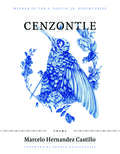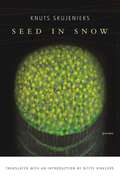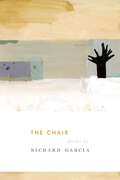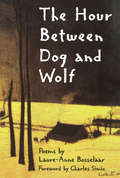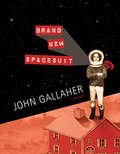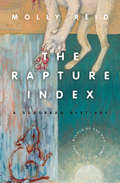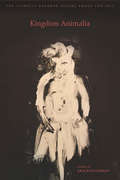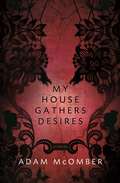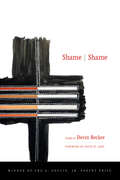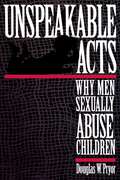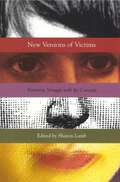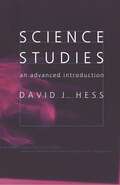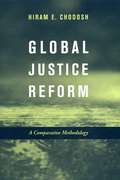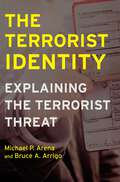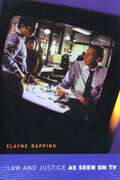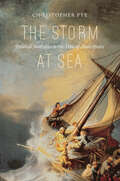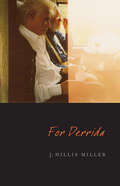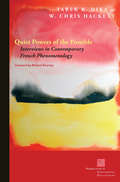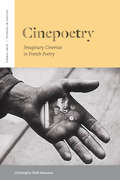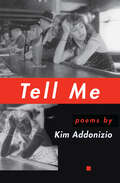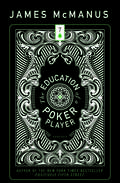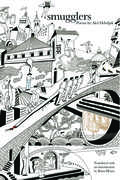- Table View
- List View
Cenzontle (A. Poulin, Jr. New Poets of America #40)
by Marcelo Hernandez CastilloWinner of the 2019 GLCA New Writers AwardAn NPR Best Book of 2018
Seed in Snow
by Knuts SkujenieksThis first U.S. publication of Knuts Skujenieks-one of Latvia’s foremost poets-is the author’s most important and widely-translated body of work. Convicted in 1962 of anti-Soviet sentiment, Skujenieks wrote these poems during seven years of imprisonment at a labor camp in Mordovia. Vivid and expressive, this collection overcomes the physical experience of confinement in order to assert a limitless creative freedom.
The Chair
by Richard GarciaOne of America's foremost prose poets, Richard Garcia's The Chair simultaneously takes place in the natural world and a speculative world rich in the fabulist tradition: historical figures roam like ghosts, time is pulled and twisted, and narrative spins effortlessly out of language. A core of autobiography grounds these poems that are rife with surprises uniting the mythic and the everyday.Richard Garcia's awards include an NEA, a Pushcart Prize, and the American Poetry Journal Book Prize. He teaches creative writing in the Antioch University Los Angeles Low-Residency MFA program and lives on James Island, South Carolina.
The Hour Between Dog and Wolf (New Poets of America)
by Laure-Anne BosselaarLaure-Anne Bosselaar's poetry captures the lives of "lost souls roaming"--be they young girls in convents, merchants, whores, widows, soldiers. Old Europe still lives in Bosselaar's rich language: Entre chien et loup, as it's known in Flanders--the time at dusk when a wolf can be mistaken for a dog.
Brand New Spacesuit (American Poets Continuum #179)
by John GallaherIn Brand New Spacesuit, John Gallaher writes with honesty, humor, and tenderness about caring for his aging parents. These poems offer snapshots of the poet’s memories of his adoption and childhood, his father’s heart attacks, his mother’s progressing Alzheimer’s disease and stroke, raising his own children, and his reflections on the complex mysteries of the universe within everyday moments. With exquisite attention to detail, Gallaher captures the losses, anxieties, and possibilities that come with caring for one another.
The Rapture Index: A Suburban Bestiary (American Reader Series #32)
by Molly ReidLoosely based on the medieval bestiary, The Rapture Index examines the relationship between animals, humans, and storytelling. Harnessing the bestiary’s combination of religious parable, encyclopedia, and artifice, Molly Reid journeys deep into suburbia to reveal characters struggling to fulfill the expectations of society and family while indulging their baser desires. Filled with moments of curiosity, misunderstanding, fervor, and heart, these stories offer a new twist on familiar landscapes where the wilderness has been tamed (sometimes just barely) but our own animal nature cannot be.
Kingdom Animalia (American Poets Continuum #131)
by Aracelis GirmayThe poems in this highly anticipated second book are elegiac poems, as concerned with honoring our dead as they are with praising the living. Through Aracelis Girmay's lens, everything is animal: the sea, a jukebox, the desert. In these poems, everything possesses a system of desire, hunger, a set of teeth, and language. These are poems about what is both difficult and beautiful about our time here on earth. Aracelis Girmay's debut collection won the Great Lakes Colleges Association New Writers Award. A Cave Canem Fellow, she is on the faculty at Drew University and Hampshire College. She lives in Brooklyn, New York.
My House Gathers Desires (American Readers Series)
by Adam McOmberAdam McOmber's lush, hallucinatory stories are both familiar and wholly original. Drawn from the historical record, Biblical lore, fairy tales, science fiction, and nightmares, these offbeat and fantastical works explore gender and sexuality in their darkest and most beautiful manifestations. In the tradition of Angela Carter or Kelly Link, My House Gathers Desires is covertly funny and haunting, seeking fresh ways to consider sexual identity and its relation to history.In "Sodom and Gomorrah," readers encounter a subversive, ecstatic new version of the Old Testament story. In "The Re'em," a medieval monk's search for a mythic beast conjures forbidden desire. And in "Notes on Inversion," the German psychiatrist Kraft-Ebbing receives a surreal retort to his clinical descriptions of same-sex desire.From "Sodom and Gomorrah":The strangers then are no longer like two men at all. They have undressed themselves, giving up the pretense of skin and becoming a denser part of the air. We are hungry for them. Ours is a sacred desire that was buried too long in our chests, like some city beneath the sand.Adam McOmber is the author of The White Forest (Touchstone, 2012) and This New & Poisonous Air (BOA, 2011), from which he had stories nominated for two 2012 Pushcart Prizes. His work has appeared in Conjunctions, Kenyon Review, and Fairy Tale Review. He served as the managing and associate editor of Hotel America at Columbia College Chicago from 2007-2015. He now lives in Los Angeles, CA, where he teaches at Loyola Marymount University.
Shame / Shame
by Devin Becker"Devin Becker's Shame | Shame is a brilliant debut collection. Here, the prose poem has been re-imagined as a cinematic vignette, yet rooted as deeply in the American Northwest as anything in Richard Hugo and David Lynch. Raw, intimate, and elliptical in its metaphysics, Devin Becker's poetry captures an idiomatic recklessness while navigating those angular narratives of our contemporary lives."—David St. John Devin Becker grew up in Fort Wayne, Indiana, and lives in Moscow, Idaho, where he works as digital initiatives librarian at the University of Idaho Library. He was named a 2014 "Mover and Shaker" by Library Journal.
Unspeakable Acts: Why Men Sexually Abuse Children
by Doug W. PryorA holistic sociological approach that explores why offenders sexually abuse childrenThe sexual abuse of children is one of the most morally unsettling and emotionally inflammatory issues in American society today. It has been estimated that roughly one out of every four girls and one in ten boys experience some form of unwanted sexual attention either inside or outside the family before they reach adulthood. How should society deal with the sexual victimization of children? Should known offenders be released back into our communities? If so, where, and with what rights, should they be allowed to live? In Unspeakable Acts, Douglas W. Pryor argues that much of this debate, designed to deal with abusers after they have offended, ignores the important issue of why men cross these forbidden sexual boundaries to molest children in the first place and how the behavior can possibly be prevented before it starts.Incorporating in-depth interviews with more than thirty convicted child molesters, Pryor explores how men become involved with breaking sexual boundaries with children. He looks at how their lives prior to offending contributed to and led up to what they did, the ways that initial interest in sex with children began, the tactics offenders employed to molest their victims over time, how they felt about and reacted to their behavior between offending episodes, and how they were ultimately able to stop. The author expands our understanding of this often reviled, little understood group, leaving us with the uneasy conclusion that the moral wall separating us from what is defined as extreme, sick behavior is not as opaque as we would like to believe.
New Versions of Victims: Feminists Struggle with the Concept
by Sharon LambIt is increasingly difficult to use the word "victim" these days without facing either ridicule for "crying victim" or criticism for supposed harshness toward those traumatized. Some deny the possibility of "recovering" repressed memories of abuse, or consider date rape an invention of whining college students. At the opposite extreme, others contend that women who experience abuse are "survivors" likely destined to be psychically wounded for life. While the debates rage between victims' rights advocates and "backlash" authors, the contributors to New Versions of Victims collectively argue that we must move beyond these polarizations to examine the "victim" as a socially constructed term and to explore, in nuanced terms, why we see victims the way we do. Must one have been subject to extreme or prolonged suffering to merit designation as a victim? How are we to explain rape victims who seemingly "get over" their experience with no lingering emotional scars? Resisting the reductive oversimplifications of the polemicists, the contributors to New Versions of Victims critique exaggerated claims by victim advocates about the harm of victimization while simultaneously taking on the reactionary boilerplate of writers such as Katie Roiphe and Camille Paglia and offering further strategies for countering the backlash. Written in clear, accessible language, New Versions of Victims offers a critical analysis of popular debates about victimization that will be applicable to both practice and theory.
Science Studies: An Advanced Introduction (Writing Science Ser.)
by David J. HessThe first comprehensive survey of the nascent field of "science studies"Thrust into the public eye by the contentious "Science Wars"—played out most recently by physicist Alan Sokal's hoax—the nascent field of science studies takes on the political, historical, and cultural dimensions of technology and the sciences. Science Studies is the first comprehensive survey of the field, combining a concise overview of key concepts with an original and integrated framework. In the process of bringing disparate fields together under one tent, David J. Hess realizes the full promise of science studies, long uncomfortably squeezed into traditional disciplines. He provides a clear discussion of the issues and misunderstandings that have arisen in these interdisciplinary conversations. His survey is up-to-date and includes recent developments in philosophy, sociology, anthropology, history, cultural studies, and feminist studies. By moving from the discipline-bound blinders of a sociology, history, philosophy, or anthropology of science to a transdisciplinary field, science studies, Hess argues, will be able to provide crucial conceptual tools for public discussions about the role of science and technology in a democratic society.
Ancient Jewish Sciences and the History of Knowledge in Second Temple Literature (ISAW Monographs #3)
by Seth L. SandersUntil very recently, the idea of ancient Jewish sciences would have been considered unacceptable. Since the 1990s, Early Modern and Medieval Science in Jewish sources has been actively studied, but the consensus was that no real scientific themes could be found in earlier Judaism. This work points them out in detail and posits a new field of research: the scientific activity evident in the Dead Sea Scrolls and early Jewish pseudepigrapha. The publication of new texts and new analyses of older ones reveals crucial elements that are best illuminated by the history of science, and may have interesting consequences for it. The contributors evaluate these texts in relation to astronomy, astrology, and physiognomy, marking the first comprehensive attempt to accountfor scientific themes in Second Temple Judaism. They investigate the meaning and purpose of scientific explorations in an apocalyptic setting. An appreciation of these topics paves the way to a renewed understanding of the scientific fragments scattered throughout rabbinic literature.The book first places the Jewish material in the ancient context of the Near Eastern and Hellenistic worlds. While the Jewish texts were not on the cutting edge of scientific discovery, they find a meaningful place in the history of science, between Babylonia and Egypt, in the time period between Hipparchus and Ptolemy. Thebook uses recent advances in method to examine the contacts and networks of Jewish scholars in their ancient setting. Second, the essays here tackle the problematic concept of a national scientific tradition. Although science is nowadays often conceived as universal, the historiography of ancient Jewish sciences demonstratesthe importance of seeing the development of science in a local context. The book explores the tension between the hegemony of central scientific traditions and local scientific enterprises, showing the relevance of ancient data to contemporary postcolonial historiography of science. Finally, philosophical questions of the demarcation of science are addressed in a way that can advance the discussion of related ancient materials.Online edition available as part of the NYU Library's Ancient World Digital Library and in partnership with the Institute for the Study of the Ancient World (ISAW).
Global Justice Reform: A Comparative Methodology
by Hiram E. ChodoshGlobal Justice Reform critiques and rethinks two neglected subjects: the nature of comparison in the field of comparative law and the struggles of national judicial systems to meet global rule of law objectives. Hiram Chodosh offers a candid look at the surprisingly underdeveloped methodology of comparative legal studies, and provides a creative conceptual framework for defining and understanding the whys, whats, and hows of comparison. Additionally, Chodosh demonstrates how theories of comparative law translate into practice, using contemporary global justice reform initiatives as a case study, with a particular focus on Indonesia and India. Chodosh highlights the gap between the critical role of judicial institutions and their poor performance (for example, political interference, corruption, backlog, and delay), discussing why reform is so elusive, and demonstrating the unavoidable and essential role of comparison in reform proposals.Throughout the book, Chodosh identifies several sources of comparative misunderstanding that impede successful reforms and identifies the many predicaments reformers face, detailing a wide variety of designs, methods, and social dilemmas. In response to these seemingly insurmountable challenges, Chodosh advances some novel conceptual strategies, first by drawing on a body of non-legal scholarship on self-regulating, emergent systems, and then by identifying a series of anti-dilemma strategies that draw upon insights about the nature of comparison.
The Terrorist Identity: Explaining the Terrorist Threat (Alternative Criminology #5)
by Michael P. Arena Bruce A. ArrigoWho would strap a bomb to his chest, walk into a crowded subway station and blow himself up? Only by examining how a terrorist understands his own identity and actions can this question be answered. The authors of The Terrorist Identity explore how the notion of self-concept combined with membership in terrorist and extremist groups, can shape and sustain the identity of a terrorist as well as their subsequent justification for violence and the legitimacy of their actions.The book provides an understanding of identity that draws on concepts from psychology, criminology, and sociology. Notably, the book examines several case studies of various terrorist groups, including: the Provisional Irish Republican Army, Hamas, the Shining Path, the Liberation Tigers of Tamil Eelam, and racist Skinheads. By making the construct of identity central to this analysis The Terrorist Identity explains how violent and extremist collective behavior emerges culturally, how it informs the identity of group members socially, and how participants assume their place in these groups completely even at the expense of life-threatening harm to others or to themselves.
Law and Justice as Seen on TV
by Elayne RappingLaw and Justice as Seen on TV examines the impact, significance, and social and political problems raised by the enormous onslaught of law-related television programming, both fiction and nonfiction, in the years since the rise of live televised trials as major media events. The book weaves together the various strands—media history and analysis, legal history and policy, and the national turn to the political right in the last decades—which gave birth to this trend and has kept it thriving and growing, by leaps and bounds, to the present day. Beginning with the history of courtroom drama on TV and its various contradictions and shifts, since the late 1940s to the present, the book analyzes the various entertainment series and genres that have so proliferated in recent years, giving special attention to such popular and influential series as "Law and Order" and "Cops." The second section begins by charting the complex and contested history of the coming of cameras to the courtroom and the way in which that legal decision led to televised trials and to the rise of Court TV. It examines as especially interesting and important the major trials—such as those of the Menendez brothers, O.J. Simpson, and Timothy McVeigh—which helped to shape the way television came to frame trials and their social implications for public consumption. From there it examines major social issues—gender violence, youth crime, family dysfunction, victims' rights which, with the rise of the courtroom as a major political and television arena, have come to be viewed largely as legal issues to be discussed and determined in legal terms by Americans in general. Accessible and lucid, Law and Justice as Seen on TV concludes with an examination of the broad implications of this social and cultural trend, closing with some thoughts about its expansion, on television and in the actual legal arena, during the "war on terrorism" in the wake of 9/11.
To the Break of Dawn: A Freestyle on the Hip Hop Aesthetic
by William Jelani Cobb2007 Arts Club of Washington’s National Award for Arts Writing - FinalistSEE ALSO: Pimps Up, Ho’s Down: Hip Hop’s Hold on Young Black Women by T. Denean Sharpley-Whiting.An inside look into the beats, lyrics, and flow of hip-hop's historyWith roots that stretch from West Africa through the black pulpit, hip-hop emerged in the streets of the South Bronx in the 1970s and has spread to the farthest corners of the earth. To the Break of Dawn uniquely examines this freestyle verbal artistry on its own terms. A kid from Queens who spent his youth at the epicenter of this new art form, music critic William Jelani Cobb takes readers inside the beats, the lyrics, and the flow of hip-hop, separating mere corporate rappers from the creative MCs that forged the art in the crucible of the street jam.The four pillars of hip hop—break dancing, graffiti art, deejaying, and rapping—find their origins in traditions as diverse as the Afro-Brazilian martial art Capoeira and Caribbean immigrants’ turnstile artistry. Tracing hip-hop’s relationship to ancestral forms of expression, Cobb explores the cultural and literary elements that are at its core. From KRS-One and Notorious B.I.G. to Tupac Shakur and Lauryn Hill, he profiles MCs who were pivotal to the rise of the genre, verbal artists whose lineage runs back to the black preacher and the bluesman.Unlike books that focus on hip-hop as a social movement or a commercial phenomenon, To the Break of Dawn tracks the music's aesthetic, stylistic, and thematic evolution from its inception to today's distinctly regional sub-divisions and styles. Written with an insider's ear, the book illuminates hip-hop's innovations in a freestyle form that speaks to both aficionados and newcomers to the art.
The Storm at Sea: Political Aesthetics in the Time of Shakespeare
by Christopher PyeThe Storm at Sea: Political Aesthetics in the Time of Shakespeare counters a tradition of cultural analysis that judges considerations of aesthetic autonomy in the early modern context to be either anachronistic or an index of political disengagement. Pye argues that for a post-theocratic era in which the mise-en-forme of the social domain itself was for the first time at stake, the problem of the aesthetic lay at the very core of the political; it is precisely through its engagement with the question of aesthetic autonomy that early modern works most profoundly explore their relation to matters of law, state, sovereignty, and political subjectivity.Pye establishes the significance of a “creationist” political aesthetic—at once a discrete historical category and a phenomenon that troubles our familiar forms of historical accounting—and suggests that the fate of such an aesthetic is intimately bound up with the emergence of modern conceptions of the political sphere.The Storm at Sea moves historically from Leonardo da Vinci to Thomas Hobbes; it focuses on Shakespeare and English drama, with chapters on Hamlet, Othello, A Winter’s Tale, and The Tempest, as well as sustained readings of As You Like It, King Lear, Thomas Kyd’s Spanish Tragedy, and Christopher Marlowe’s Doctor Faustus. Engaging political thinkers such as Carl Schmitt, Giorgio Agamben, Claude Lefort, and Roberto Esposito, The Storm at Sea will be of interest to political theorists as well as to students of literary and visual theory.
For Derrida
by J. Hillis MillerThis book—the culmination of forty years of friendship between J. Hillis Miller and Jacques Derrida, during which Miller also closely followed all Derrida’s writings and seminars—is “for Derrida” in two senses. It is “for him,” dedicated to his memory. The chapters also speak, in acts of reading, as advocates for Derrida’s work. They focus especially on Derrida’s late work, including passages from the last, as yet unpublished, seminars. The chapters are “partial to Derrida,” on his side, taking his part, gratefully submitting themselves to the demand made by Derrida’s writings to be read—slowly, carefully, faithfully, with close attention to semantic detail.The chapters do not progress forward to tell a sequential story. They are, rather, a series of perspectives on the heterogeneity of Derrida’s work, or forays into that heterogeneity.The chief goal has been, to borrow a phrase from Wallace Stevens, “plainly to propound” what Derrida says. The book aims, above all, to render Derrida’s writings justice. It should be remembered, however, that, according to Derrida himself, every rendering of justice is also a transformative interpretation. A book like this one is not a substitute for reading Derrida for oneself. It is to be hoped that it will encourage readers to do just that.
Quiet Powers of the Possible: Interviews in Contemporary French Phenomenology (Perspectives in Continental Philosophy)
by Tarek R. Dika W. Chris HackettQuiet Powers of the Possible offers an excellent introduction to contemporary French phenomenology through a series of interviews with its most prominent figures.Guided by rigorous questions that push into the most important aspects of the latest phenomenological research, the book gives readers a comprehensive sense of each thinker’s intellectual history, motivations, and philosophical commitments.The book introduces readers to debates that have not previously been accessible to the English-speaking world, such as the growing interest in the phenomenological concept of life in its affective and even vital dimensions, the emerging dialogue with the analytic philosophy of mind and language, and reassessments of the so-called theological turn.The diversity of approaches collected here has its origin in a deeper debate about the conceptual and historical foundations of phenomenology itself. In this way the book offers the most accessible and wide-ranging introduction to French phenomenology to have appeared in the English-speaking world to date.
Cinepoetry: Imaginary Cinemas in French Poetry (Verbal Arts: Studies in Poetics)
by Christophe Wall-RomanaCinepoetry analyzes how French poets have remapped poetry through the lens of cinema for more than a century. In showing how poets have drawn on mass culture, technology, and material images to incorporate the idea, technique, and experience of cinema into writing, Wall-Romana documents the long history of cross-media concepts and practices often thought to emerge with the digital.In showing the cinematic consciousness of Mallarmé and Breton and calling for a reappraisal of the influential poetry theory of the early filmmaker Jean Epstein, Cinepoetry reevaluates the bases of literary modernism. The book also explores the crucial link between trauma and trans-medium experiments in the wake of two world wars and highlights the marginal identity of cinepoets who were often Jewish, gay, foreign-born, or on the margins.What results is a broad rethinking of the relationship between film and literature. The episteme of cinema, the book demonstates, reached the very core of its supposedly highbrow rival, while at the same time modern poetry cultivated the technocultural savvy that is found today in slams, e-poetry, and poetic-digital hybrids.
Tell Me (American Poets Continuum)
by Kim AddonizioIn this new collection by the author of the award-winning The Philosopher's Club, Kim Addonizio takes the grist of the world and transforms it into poems of transcendent beauty. The dual themes of love and loss are pervasive in Addonizio's poems, made poignant by her keen eye and wise observations.
Not for Specialists: New and Selected Poems (American Poets Continuum)
by W.D. SnodgrassUntil the late 1970s, W. D. Snodgrass was known primarily as a confessional poet and a key player in the emergence of that mode of poetry in the late 1950s and early 1960s. Snodgrass makes poetry out of the daily neuroses and everyday failures of a man—a husband, father, and teacher. This domestic suffering occurs against a backdrop of more universal suffering which Snodgrass believes is inherent in the human experience. Not for Specialists includes 35 new poems complemented by the superb work he wrote in the Pulitzer Prize winning collection, Heart’s Needle, along with poetry from seven other distinguished collections.from "Nocturnes"Seen from higher up, it makes its first move in the low creekbed, the marshlands down the valley, spreading across the open hayfields, the hedgerows with their tops still lit, laps the roadbed, flows over lawns and gardens, past the house and up the wooded hillside back behind us till only some few rays still scythe between the treetrunks from the far horizon and are gone.W. D. Snodgrass, born in Pennsylvania in 1926, is the author of more than 20 books of poetry, including The Fuehrer Bunker: The Complete Cycle (BOA, 1995); Each in His Season (BOA, 1993); and Heart's Needle (1959), which won the Pulitzer Prize for Poetry. His other books include To Sound Like Yourself: Essays on Poetry (BOA, 2002), After-Images: Autobiographical Sketches (BOA, 1999) and six volumes of translation, including Selected Translations (BOA Editions, 1998), which won the Harold Morton Landon Translation Award.
The Education of a Poker Player
by James McManus"In writing about poker Jim McManus has managed to write about everything, and it's glorious."—David SedarisNew York Times-bestselling author James McManus offers up a collection of seven stories narrated by Vincent Killeen, an Irish Catholic altar boy, in the late 1950s and early 1960s. Persuaded at age eight by his grandmother that entering the priesthood will guarantee salvation for every member of his family, Vince eagerly commits to attending a Jesuit seminary for high school. As the meaning of a vow of celibacy becomes clearer to him, however, and he is exposed to the irresistible temptations of poker and girls, life as a seminarian begins to seem less appealing. These autobiographical stories are enlightening and evocative, providing keen, often humorous insight into Catholicism, faith, celibacy and its opposite, as well as America's—and increasingly the world's—favorite card game.James McManus has been called "poker's Shakespeare." He is the New York Times-bestselling author of Positively Fifth Street: Murderers, Cheetahs, and Binion's World Series of Poker and Cowboys Full: The Story of Poker, among others. He has been the poker columnist for the New York Times and currently writes the history column for CardPlayer. His work has also appeared in Harper's, The Believer, Paris Review, Esquire, and in Best American anthologies for poetry, sports writing, science and nature, and magazine writing. He has spoken about poker at Yale, Harvard, Google, Goldman Sachs, and on numerous media outlets, and is the recipient of the Peter Lisagor Award for Sports Journalism and fellowships from the Guggenheim and Rockefeller foundations, among other awards. He teaches at the School of the Art Institute of Chicago.
Smugglers
by Ales DebeljakThe poems in Smugglers move through rapid historical shifts and meditations on personal experience, exploring the depths and limits of comprehension through the people and geography of the Balkans. Ultimately, Aleš Debeljak's urban imagination creates a mosaic—intimate and historical—of a vanished people and their country. Every poem in Smugglers is sixteen lines long—four quatrains, a common form for Debeljak. This structural regularity is reinforced by a commitment to visual balance, with each poem working as a kind of grid into which the poet pours memories and associative riffs.From "Bookstore":At least you are blessed. Winter's here. In darkness, awakesince yesterday, I came to browse again through the titles of oldbooks, wobbly skyscrapers, writers of my youth and stiffened honey.No opening hours on the door, a minor poet with no womansits behind files in the front. I know him from whenwe all shouted in one loyal voice, collected works on salefor a handful of cents, read the holy Kapitallike zealots. Well, okay: not exactly all. Some of us tookanother road . . .Aleš Debeljak's books have appeared in English, Japanese, German, Croatian, Serbian, Polish, Hungarian, Czech, Spanish, Slovak, Finnish, Lithuanian, and Italian translations. He teaches in the department of Cultural Studies at the University of Ljubljana in Slovenia.Brian Henry is the author of ten books of poetry and won the 2011 Best Translated Book Award. He teaches at University of Virginia in Richmond, Virginia.
